The Zero-Dollar Dream Job: How to Win the War for Talent and Build a Company Everyone Wants to Join
Founder OS: A real-world playbook for attracting top talent, building culture, and creating momentum before your first dollar hits the bank
Some of the best companies in the world weren’t funded. They were followed.
Before the pitch decks, before the VC intros, before the seed round with a fancy lead, there was just a founder with conviction, clarity, and a few true believers who said: I’m in.
No salary. No safety net. All they had was shared momentum and a mission that mattered to them.
What used to be the norm now feels like an exception. Somewhere along the way, founders started believing they couldn’t build a real team without raising capital first.
But that’s a myth. The best early-stage founders today aren’t waiting for funding to attract talent. They’re creating so much gravity that people come to them.
This article is your playbook for doing exactly that.
How do you assemble a crew before you have cash? How do you earn trust, offer real upside, and build early culture without a payroll?
These are the questions every founder asks, and we’re going to answer them using real, field-tested moves from founders who built momentum before money.
Welcome to the founder’s guide to building magnetic gravity before your first check.

1. Start with a Mission People Believe In
When you don’t have money, your mission is your offer.
Early-stage teams don’t form around compensation packages. They simply form around belief. That belief starts with the founder and how clearly they can articulate why this company must exist, and why it has to exist now.
If you can’t pay people, you need to give them something even stronger: meaning. That’s what draws the first designer, the part-time engineer, the late-night contributor. It’s not perks or creative job titles. It’s giving them a reason to care.
Clarify Your “Why” in 2–3 Sentences
Strip your story down to the core truth.
Why does this product need to exist?
Why are you the one to build it?
What will be different in the world if it succeeds?
Forget grandstanding. This isn’t for investors. It’s for people who want to build something that matters. Example:
“We’re building this because it should exist, and no one else is crazy enough to try.”
“We’re not hiring. We’re assembling a team to solve this together.”
“This problem keeps us up at night. If it hits, it changes everything.”
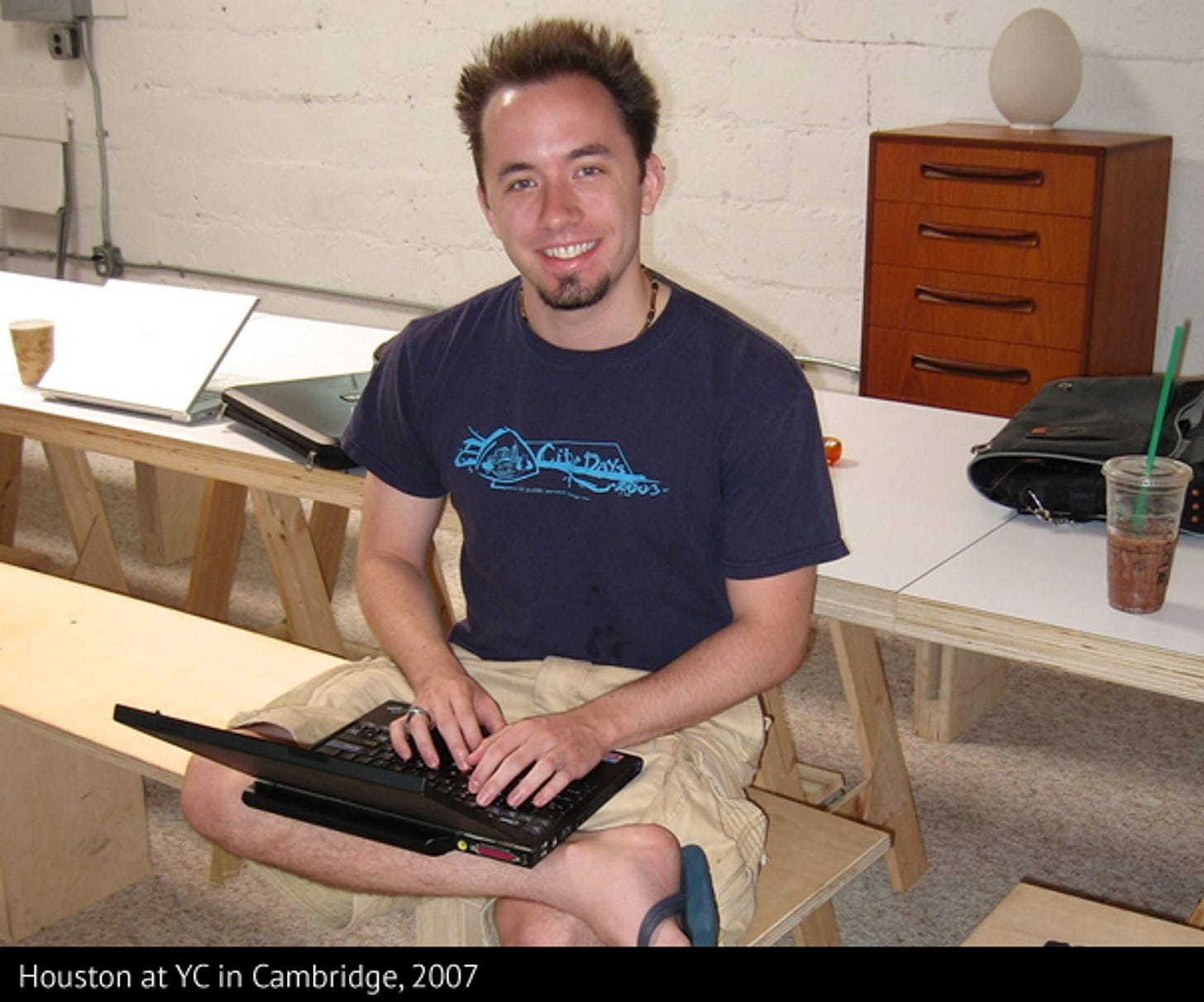
What Makes a Mission Magnetic
Three key ingredients will make a mission feel enchantic.
Urgency: “This can’t wait two years. It’s needed now.”
Emotional Stakes: “This problem is personal to us, and to millions of others.”
Bigger Than You: “It’s not about us building a company. It’s about creating a wave.”
Early Notion contributors, early Figma believers, early Stark community members; they all showed up for the sake of the mission; not for the compensation.
Where to Broadcast It
Your mission shouldn’t live in a slide deck. It should be everywhere people might discover you:
Your landing page
Your X bio and pinned post
Your Linkedin header
Your GitHub README
Your “Join us” doc or pitch deck
Make it easy for someone to read 3 lines and say, “I believe in this too.”
At this stage, don’t invite people to apply. Invite them to build. To build with you.
It’s all about the framing. “We’re looking for people to jam with us” lands differently than “We’re hiring a product designer.”
Remember, this is not about screening candidates, but about opening conviction.
2. Design Equity to Feel Like Real Ownership
You’ve got the belief. Now you need the buy-in.
Early contributors might sign up for the mission, but they’ll stay for the upside. That means your equity offer can’t feel like a fuzzy promise. It has to feel real, fair, and worth betting on.
Most founders get this wrong. They either lowball equity out of fear of dilution, or hand it out without structure, which breeds confusion or resentment later.
But both of those scenarios are catastrophic. If equity is your only currency, you have to make it count.
Be Generous, But Smart
According to Carta’s 2024 equity data, equity grants are down 37% since the 2021 peak. But expectations haven’t dropped. Talent still wants meaningful ownership, and they should.
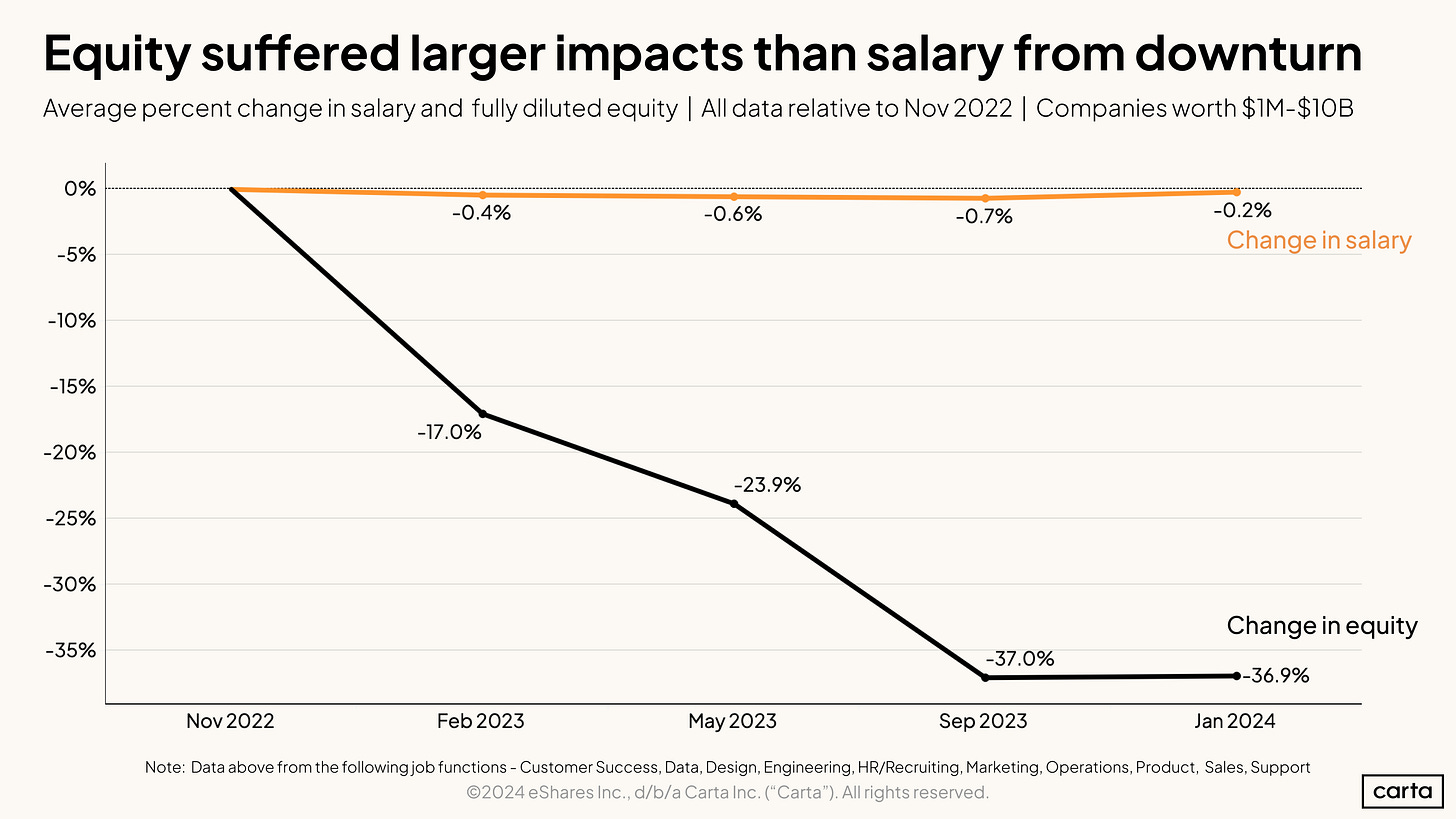
Here’s a practical starting point:
Founding engineer (full-time): 1.5–2%
Part-time contributor: 0.1–0.25%
Advisor: 0.25–0.5%
Tools like Index Ventures’ OptionPlan or VC Corner’s Option Grant Calculator can help you benchmark your offers. Use them as trust-building tools.
Make the Mechanics Transparent
A great equity offer isn’t just generous, it’s clear and leaves no room for ambiguity. Break it down simply:
Vesting: 4 years with a 1-year cliff (standard, protects both sides)
Dilution: Explain it upfront. “If we raise $3M on a $15M post, your 1% becomes 0.85%. Still significant, still valuable.”
Exit scenarios: Show the math. “If we sell for $50M, your stake = $500K.” Now it feels real.
Once again, framing is extremely important. Instead of saying “equity grant,” say “ownership in what we’re building.” Don’t say “standard vesting.” Say “We want you to grow into this with us.”
Equity Is How You Signal Respect
Ultimately, early teammates are your co-builders. If they’re helping shape the foundation, they deserve a meaningful stake in the outcome. Especially if they’re taking a pay cut or working for free.
Instead of offering less equity to protect yourself, try to see things from their perspective by asking what will make them feel like a founder and not just a helper.
Because if they feel like owners, they’ll show up like owners.
3. Culture First, Compensation Second
Money might get someone’s attention. But culture is what keeps them around.
When you’re building without funding, you can’t win talent by offering the highest pay. What you can offer is something far rarer.
You can offer a place where people feel trusted, energized, and free to do their best work. That’s the real magnet.
Study the Outliers
Legendary companies like Valve and W.L. Gore have operated for decades without traditional hierarchies. No titles. No fixed teams. Just open allocation; a system where people choose what to work on and who to work with.
W.L. Gore calls it the “sponsor model”: if someone wants to lead something, they find a peer willing to back them.
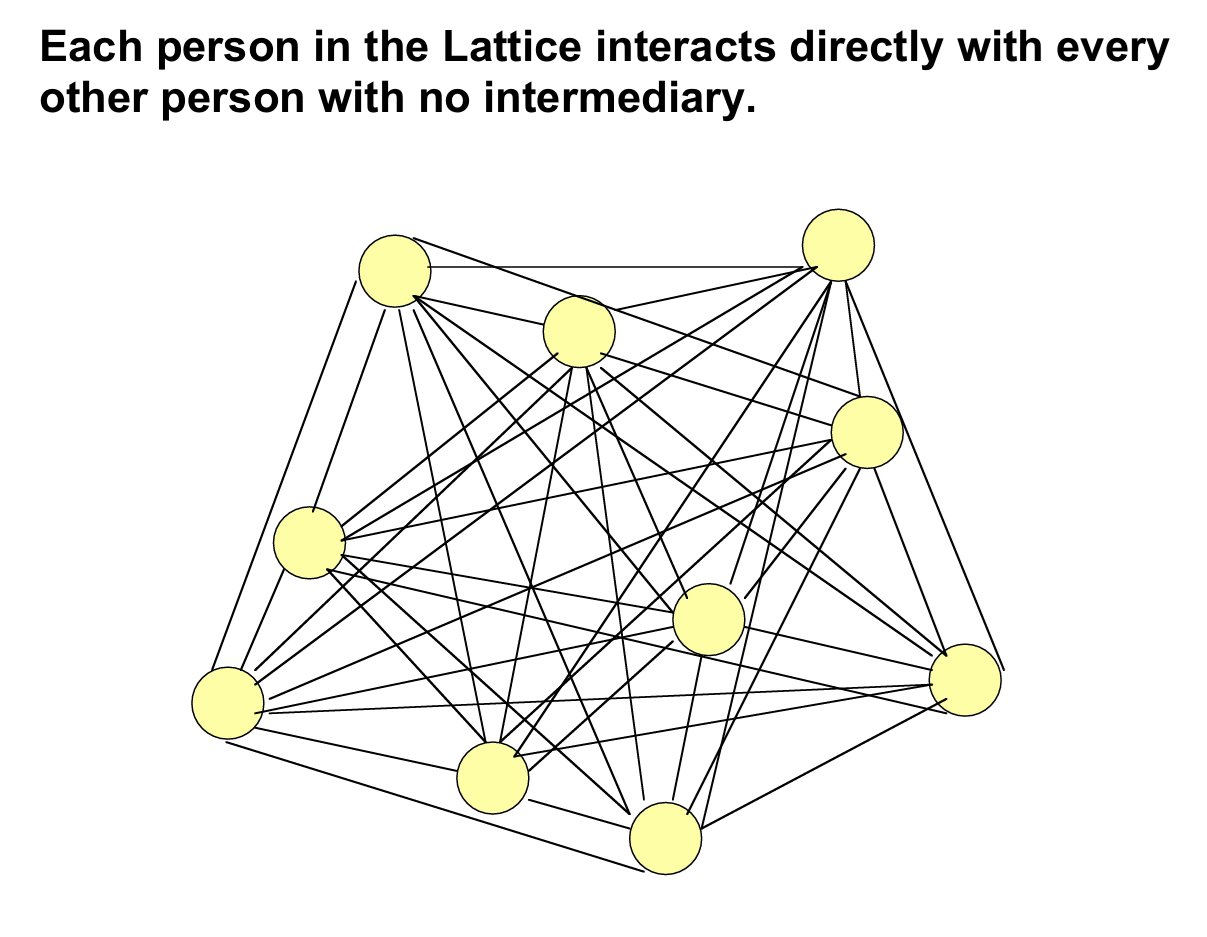
Some might call it chaos, but it also means trust.
You don’t need fancy perks or management layers to create a high-trust culture. Here’s what actually matters: let people pick their projects. Invite them to solve real problems and not just execute tasks.
Replace top-down control with clear context and high autonomy. Celebrate experiments, not just outcomes. Build a place where momentum matters more than perfection.
At early Google, transparency was the default; not just a value. New hires got access to nearly every internal document from day one. There was no gatekeeping, no permission theater. Engineers didn’t wait for approvals or roadmap blessings, they chased ideas, convinced one another, and shipped.
Objectives and Key Results (OKRs) existed, but they weren’t weaponized or top-down. People contributed because they cared, not because they were assigned. Collaboration wasn’t performative; it was spontaneous and self-organizing.
And although that wasn’t “culture” in the HR sense, it meant clarity and trust, lived day to day. No compensation package can compete with that.
Founders often obsess over tools: which project tracker, which productivity stack. But trust isn’t built with software. It’s built with consistency, transparency, and shared purpose.
So skip the micromanagement. Skip the Monday standups that feel performative. Instead, ask: What kind of company would I want to work for if I wasn’t getting paid?
Then build that. That’s your moat.
4. Creative Recruiting with Zero Budget
When you can’t offer cash, you have to offer curiosity.
Early recruiting isn’t about job listings, it’s about pulling the right people into your orbit. And the best founders know how to do it without a single dollar spent on ads or recruiters.
Look at what Exa did. Frustrated with the usual hiring channels, they skipped LinkedIn entirely and started posting math puzzles across San Francisco. No fancy logos. No creative job ads.
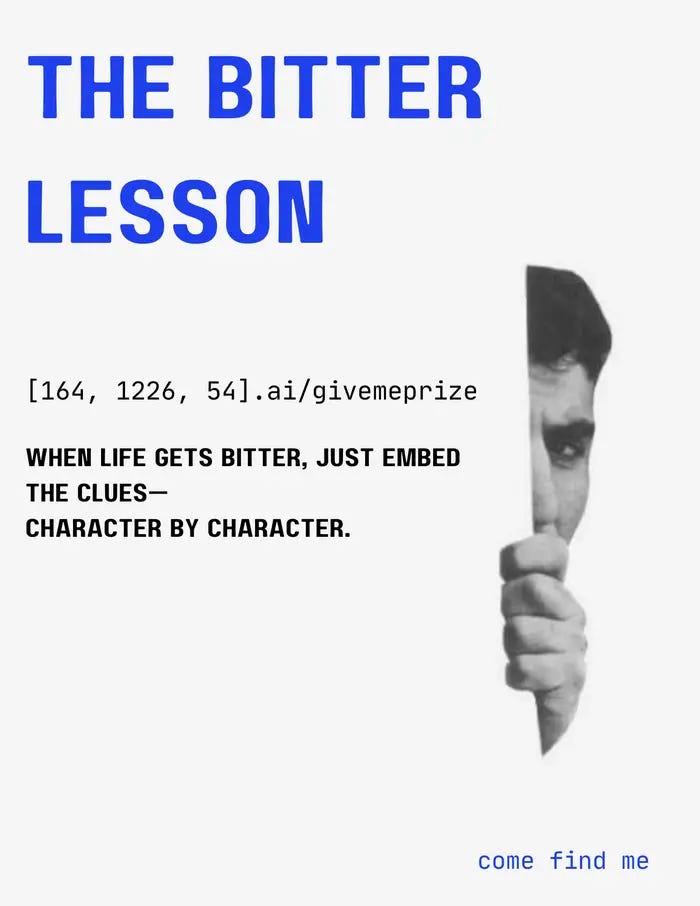
Just curiosity bait. Solve the puzzle, and it leads you to a website, and eventually, an invite to dinner with the team. The result was over 100 applicants, including engineers from Google, Apple, and top-tier PhD candidates, all drawn in by vision instead of comp packages.
This process is about cultivating a mindset: great recruiting starts as an invitation to collaborate.
Hackathons are another zero-cost unlock. Startups like ElevenLabs and Mistral have used them not only to ship features but to spot potential hires in the wild.
In the current AI wave, hackathons have quickly become the place where top talent reveals itself, often before it even hits the job market. And you don’t even need to host one. Just show up, contribute, and keep your radar on.
Meanwhile, companies like Replit, Vercel, and Ramp built much of their early teams through Twitter. They skipped the “we’re hiring” posts and went straight to posting what they were building. Weekly updates. Real metrics. Design decisions. Roadmap questions. It created an open current that others could swim into. Some of their best hires came through cold DMs after a product thread or a build breakdown.
You can do the same:
Run an “open problem” sprint and share it publicly.
Drop puzzles or design prompts in your Discord or Slack community.
Ask for referrals in 1:1 DMs to founder friends. Tell them you’re not hiring, but you are looking for likeminded people to talk to.
Track your traction and share it. Numbers, users, even flops. That kind of honesty builds pull.
Because great early recruiting isn’t about filling a role. It’s about making noise that signals: something exciting is happening here. And the right people always show up for that.
5. Build a Contributor Ecosystem Before You Build a Payroll
You don’t need a headcount to build momentum. You need a crew, and not everyone on that crew has to be on payroll.
The most resourceful founders know how to create energy around their product before they can afford formal hires. They build contributor ecosystems: loose, opt-in communities of designers, engineers, researchers, testers, and evangelists who show up because they want to. Not because they’re paid to.
Companies like Stark, Notion, Linear, and dozens of open-source projects have scaled reach and velocity long before building large internal teams. Stark’s contributor program helped shape its accessibility features. Notion’s early ambassadors built templates, ran local events, and even translated the product.
And none of them were full-time. They were believers. And they were treated like partners.
A contributor isn’t an employee. But they’re also more than a follower. They're someone who gives time, insight, or effort, on their terms. It could be a designer contributing four hours a week, a developer reviewing GitHub issues on weekends, or a beta tester running weekly UX feedback sessions.
Some write “how-to” guides for your community just because they believe in what you’re building. These people exist and are everywhere, you just have to make it easy and exciting for them to plug in.
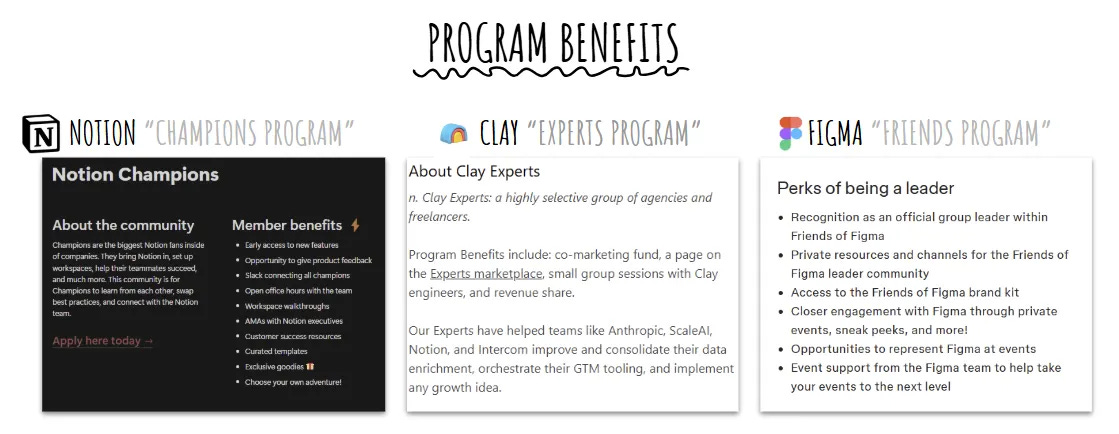
Start by creating a Contributor Handbook. Keep it in Notion. Lay out what kinds of help you need, how to get involved, and what contributors can expect in return. Be honest, if you can’t pay yet, say so. But make the upside clear, whether it’s public recognition, early access, or a pathway to future equity or core team roles.
Bring contributors into your Slack or Discord. Treat them like teammates, not side characters. Let them ship real features or content themselves. When someone goes above and beyond, spotlight them in a blog post, tag them publicly, give them a “Builder’s Badge” on your site. Acknowledgment matters.
As they stick around, open the door wider and wider. Offer part-time equity grants. Invite them into roadmap reviews. Let them grow into the role before you offer a title. And when the moment comes to build the full-time team, you won’t need to post a job, you’ll already know who should be there.
GitHub, Notion, Slack, and tools like Coho or Sismo can help organize it all. But what really powers a contributor ecosystem isn’t just software, it’s a founder who knows how to attract belief before they can afford salaries.
Play the long game. Build a place worth showing up to.
Before payroll, build trust. Before perks, build community. That’s how great teams form, even when there’s no money in the bank.
6. Ditch the Founder-as-Boss Mentality
Early-stage teams more often fall apart because the founder acted like a boss than because the idea was bad.
A founder at the early stages isn’t about managing employees. That’s a huge trap many first-time founders fall into.
No, an early-stage founder’s mission is to assemble a crew. People aren’t joining for titles or structure, they’re showing up because they believe in you and what you’re building. So stop thinking about the organization chart. Stop thinking about hierarchies. Start thinking like a collaborator.

Don’t hire to delegate like a CEO. Invite people to co-build. Don’t run interviews. Have conversations. Share your vision, your roadmap, your open problems, and see who leans in. That’s your ultimate signal.
Skip the onboarding packet. Instead, write a one-page “Here’s what I’m stuck on.” Then find people to brainstorm together with.
Your job isn’t to approve work. It’s to create momentum and clarity. Treat every early team member like a founder-in-training. Give them autonomy, context, and skin in the game. When people feel ownership, they don’t wait for permission. They build, They contribute. They elevate what’s already there.
The moment you slip into corporate patterns like status checks, control loops, formal performance reviews, you lose what made your company magnetic in the first place.
You’re not a boss. You’re the gravity. Act like it.
7. Momentum Is the New Money
In 2025, it’s not capital that attracts great talent.
It’s motion.
People aren’t joining because you raised a round. They’re joining because you shipped last week, tweeted about it, and had users commenting by morning. They’re joining because they saw something move and thought, “I want to be part of that.”
Momentum is the strongest hiring signal you have. And it’s free.
Even a tiny product update, a new landing page, a raw thread about a failed experiment; those are all proof points that you’re not just talking. You’re actually building. You have skin in the game. And that movement creates gravity.
Founders often overthink this. You don’t need virality. You need consistency. A weekly update on X. A changelog on your site. A post about user feedback in your Discord. The people you want are already scanning the feed for momentum, and they’ll gravitate towards you.
So if you’re struggling to hire, don’t ask who’s available. Ask what you’ve built lately that would make someone want in. Because in the earliest stage, traction is louder than capital. And momentum is the real currency.
8. Parting Thoughts: Build First, Hire Later, Lead Always
You don’t need a million-dollar round to build a team. You need belief, clarity, and momentum.
The best founders don’t wait for funding to attract talent. They write the memo, ship the v0, post the update, take the call. They invite people in before the company looks like a company. And that’s exactly why others follow.
This isn’t a cheat code. It’s the actual work. The culture you build now, when no one’s watching, when no one’s paying, is the culture people will line up to join later.
So stop waiting for permission. Start broadcasting. Start building. Start inviting the kind of people who don’t need a comp package to believe, just a reason to care.
The gravity starts with you. Make it undeniable.
Read more from Founders Corner:
CEO-Level Strategies for Confident Negotiation
How to Delegate Like a Founder CEO
Co-Founder Conflict 101: Should You Stay Together or Part Ways?



I'm delighted someone’s finally written this all down in one place. So many founders I speak to are waiting on the cheque before they move but it’s belief that builds the team, not the bank account.
According to First Round Capital, founders who build community before product are 2x more likely to attract early hires: https://review.firstround.com/the-importance-of-community-in-early-stage-startups
At the end of the day, it's all about the people. Hiring slow is so important to get the right people on your bus.